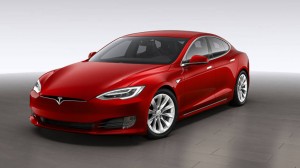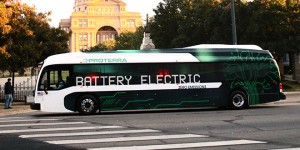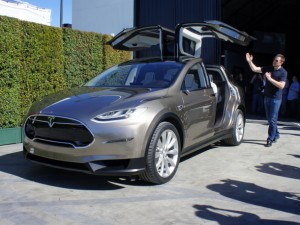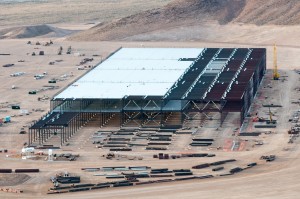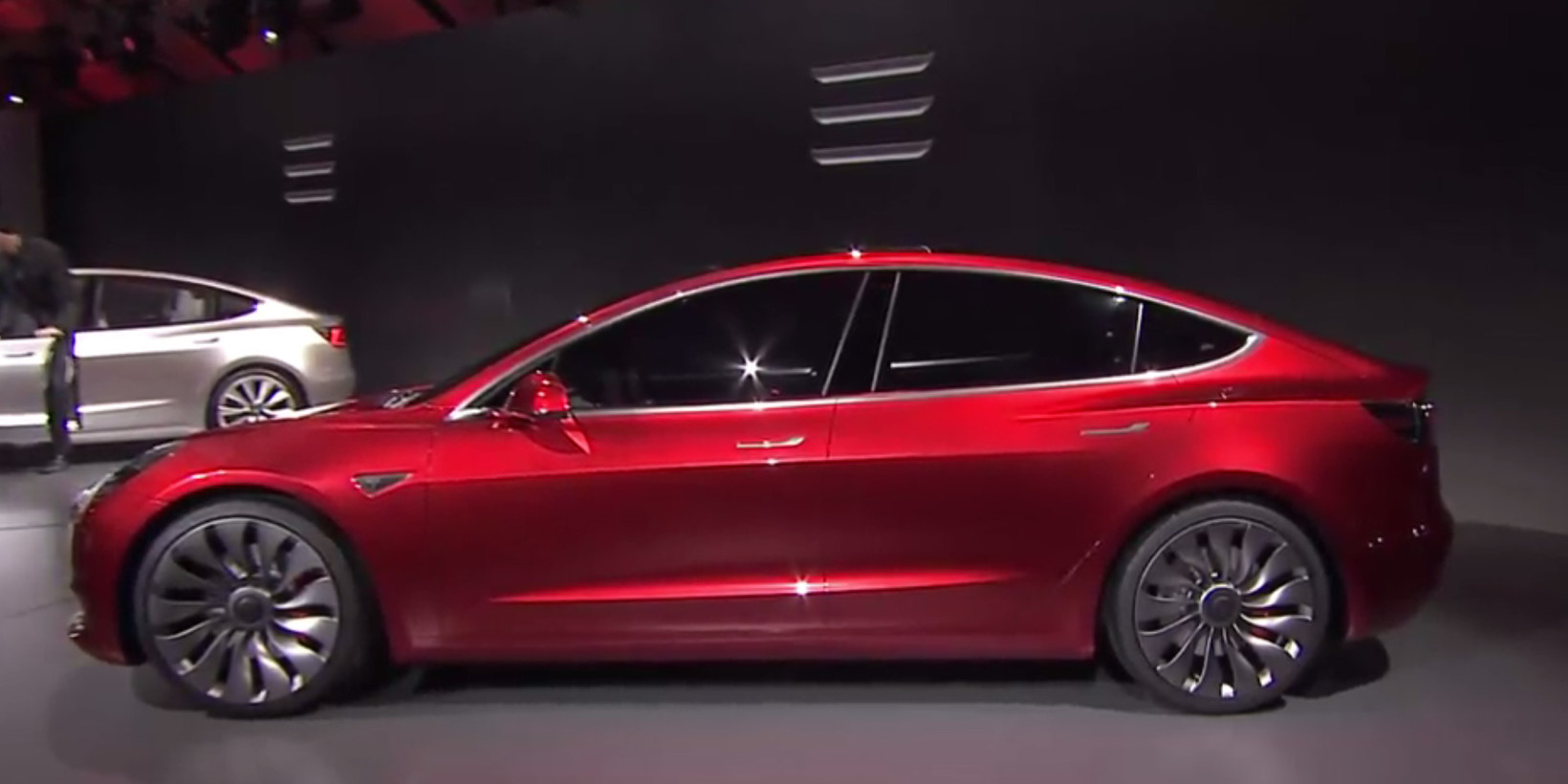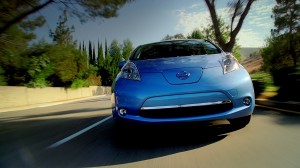Tesla is at it again, this time bumping their biggest battery pack size from 90 kilowatt hours up to the century threshold at 100 kwh. Why is this a big deal? It gives the Model S a range of over 300 miles now, which marks the first time an electric vehicle in production can get you that far on a single charge.
Or as Elon Musk says, you can now get from Los Angeles to San Francisco on a single charge (actually that’s dubious given the mountains, and at best would only get you to Los Angeles County, but still).
As an added bonus, the Tesla P100D is now the fastest car in production in the world, able to go 0 to 60 mph in 2.5 seconds (and third fastest ever).
But the range is the most noteworthy thing. Here we are in 2016, and you can have a 300-mile range electric car. Granted, the cost is prohibitive for all but the most wealthy, but prices are coming down steadily. It won’t be long, given current trends, before an electric vehicle could have a range of 600 or even 700 miles. And once the price comes down on those cars, maybe by the middle or end of the next decade, a lot of discussion about “range anxiety” and access to public charging infrastructure becomes largely moot.
Tesla’s master plan foresees electric buses but also autonomous, smaller mini-buses that can serve people on demand and take them right to where they want to go:
With the advent of autonomy, it will probably make sense to shrink the size of buses and transition the role of bus driver to that of fleet manager. Traffic congestion would improve due to increased passenger areal density by eliminating the center aisle and putting seats where there are currently entryways, and matching acceleration and braking to other vehicles, thus avoiding the inertial impedance to smooth traffic flow of traditional heavy buses. It would also take people all the way to their destination. Fixed summon buttons at existing bus stops would serve those who don’t have a phone.
This development is significant for two reasons. First, the push into the bus realm helps overcome some of the tension between electric vehicles and transit advocates. The electrification of transportation, as I’ve written before, reduces pollution from vehicles and also undermines the pro-transit argument that more buses and trains offsets pollution from gas-guzzling passenger vehicles. So if Tesla is improving transit vehicles, that gives anti-car, pro-transit advocates a reason to like the company.
Second, Tesla’s automated driving technology could greatly improve the service of transit. What bus user wouldn’t love transit on-demand that gets you right to where you want to go?
But some transit advocates aren’t buying it. Jarrett Walker at Human Transit thinks Musk’s vision will bump up against a “geometry problem”:
But when we get to dense cities, where big transit vehicles (including buses) are carrying significant ridership, Musk’s vision is a disaster. That’s because it takes lots of people out of big transit vehicles and puts them into small ones, which increases the total number of vehicles on the road at any time. The technical measure of this is Vehicle Miles (or Km) Travelled (VMT).
He bristles at the idea that technology boosters like Musk want to do away with the traditional fixed-route bus, which underpins mobility in dense urban environments.
But Walker never acknowledges that Musk does in fact address the “geometry” problem: automated mini-buses, in a world of all autonomous vehicles within dense city centers, will have the ability to “platoon” — essentially tailgate on steroids. Since the vehicles are all communicating with each other, they can drive bumper to bumper like train cars, freeing up a huge amount of street space.
Or as Musk writes, these mini-buses will be “matching acceleration and braking to other vehicles, thus avoiding the inertial impedance to smooth traffic flow of traditional heavy buses.”
I’m not an engineer, so I can’t say definitively that the gains in street space from platooning will offset the increase in vehicle traffic from mini-buses. But theoretically, it seems to me that we can achieve Musk’s vision and still have the dense urban environment and mobility of fixed-route buses, as Walker advocates.
All of this is still a ways off in the future, but not as far as many people might think. If Musk is correct on the timing, it could happen with the next decade. At that point, we may all be in electric vehicles, even if we live in a dense city and never drive a car.
I’m back from vacation, and while a lot has happened since I was away, the big story seems to be the unveiling of Tesla’s 2.0 master plan — at least on the environment and energy front. The key stand-outs for me are:
- The diversity of transportation modes that Tesla wants to electrify: It’s not just about passenger vehicles anymore, as Tesla wants to build buses and cargo trucks, too. And of course, the expansion into pickup trucks and compact SUVs are noteworthy.
- Autonomous driving will take a while: Musk writes that while the technology is being tested, regulatory policies are still way behind, especially taking into account all the jurisdictions around the globe. He anticipates another 5 years or so before fully autonomous vehicles are allowed everywhere.
- The big play on residential and commercial batteries for solar: the new acquisition of SolarCity has solidified this approach, but the master plan is clearly betting on solar incentives changing across the country. Right now it’s a pretty good deal to get rooftop solar in most places, but there are no incentives to capture surplus solar in a battery as long as customers are getting full retail credit from their utility for it. Musk seems to betting that retrenching these incentives, as Nevada and Hawaii have done, will become the norm and will therefor provide an opportunity for batteries. It could also set up Tesla as a bit of an opposition force to traditional solar installers in these state battles, as those companies generally don’t want solar incentives shifted to batteries.
I’ll have more thoughts soon in particular on the Tesla play for buses and transit. But in the meantime, Musk has given the public a lot to chew on.
The proposed merger between Tesla and SolarCity has a lot of Wall Street types grumbling. But as I wrote a few weeks ago, the deal makes some sense in the short run and has the outside potential for major gains unlike anything we’ve seen in the energy space.
Now the Chicago Tribune spells out some of the specifics of the upside for the company, much of which is predicated on likely policy changes to solar policy in the U.S.:
Net metering rules, which require electric utilities to buy back rooftop solar from customers at retail rates, are the biggest U.S. subsidy for solar power. But as solar power spreads, the policy will begin to destabilize grid economics. Several states have reversed their rules already, most notably Nevada, where the abruptness of the turnabout left customers in the lurch with overbuilt solar systems and no way to recoup costs. Higher-capacity battery storage will eventually allow solar customers to profit from their solar systems with or without net metering. It’s investment security for the homeowner.
Essentially, Tesla is betting — with good reason — that states will likely start encouraging battery installation along with solar panels.
The article also notes that Tesla may be able to aggregate all of its customers’ battery power to sell this flexible resource to the wholesale electricity market to provide various grid services, distributing the revenue to its customers in the form of reduced energy bills or cash payments.
My only quibble is that the “frequency regulation” market that the article cites is lucrative but relatively small. So the company may have better success aggregating all this flexible demand to be responsive to grid needs (essentially to match renewable generation).
So in the near term, Tesla can benefit by selling solar panels in its showrooms. In the medium term, it can bet on battery incentives in many states and the possibility of aggregating all of its customers’ energy resources to sell to grid operators. And in the long run, as costs continue to decline and new technologies become available, the company could very well supplant traditional utilities by managing all of your energy — and transportation — needs.
Not a bad play, all in all.
Occasionally I hear criticisms of the electric vehicle push that we are simply replacing one limited resource (oil) with another (lithium and other raw materials for EV batteries).
Yet knowledgeable people seem to indicate that the resource issue isn’t real and that plenty of materials exist to power the world over with batteries.
Now Bloomberg reports on Tesla’s efforts to lock up the raw materials it needs for its big battery push, with the potential for competition from international actors who also need batteries for their consumer products:
For its batteries, Tesla typically uses formulations including lithium, nickel, cobalt, and aluminum oxide. To find a steady and affordable supply of these materials—key to keeping the base price of the Model 3 at about $35,000—the company is recruiting staffers to scour the globe. It hired Rene LeBlanc, a former engineer at FMC Lithium, earlier this year. It’s also looking for a Tokyo-based supply-chain analyst willing to travel frequently to China and South Korea to work closely with suppliers.
Despite all the buzz about lithium, Musk reminded investors at Tesla’s May 31 shareholder meeting that the metal is “just the salt on the salad,” accounting for only about 2 percent of the material in Tesla cells. Yet it’s key to making batteries rechargeable, and even that small percentage doesn’t exempt Tesla from the laws of supply and demand. It’s competing for the metal with companies in Asia, where China, Japan, and Korea account for more than 85 percent of current lithium ion battery output, according to researcher CRU Group.
This race for resources will likely spur innovation, as Tesla is already trying to swap out more expensive cobalt for nickel, and battery innovation could change the chemical and metallic needs of future batteries.
But it’s an interesting dynamic to track, as it ultimately determines the price of the batteries, which determines the price of the vehicles, which determines their popularity to consumers, which determines how quickly we can transition away from oil and stabilize the planet’s climate in the process.
As has been widely reported, Tesla is making moves to buy solar installer SolarCity. The two companies have family relations, with Elon Musk’s cousins running SolarCity and with Musk serving as chairman of the board, in addition to his role running Tesla.
Does the deal make sense? At a basic level, yes (although doubts persist about the short-term economics). Tesla is already distributing its batteries through SolarCity, and many Tesla customers will be interested in solar, once their electricity bill goes up as they charge at home. So there are obvious synergies: — Tesla can advertise for SolarCity in their showrooms for example, and SolarCity can promote Tesla vehicles and batteries.
But in the long term, Musk is aiming for a monopoly on a magnitude we’ve rarely if ever seen before, outside of the old company town. Essentially, Tesla seeks to own your transportation and home energy, all in one corporate clean energy “ecosystem.” It will become your utility, car company, and gas station, all in one — only without the emissions of our current system.
Musk is a friend and former business partner of Peter Thiel, the famed PayPal investor who preaches the virtues of such monopolies. Thiel essentially argues that if you’re an entrepreneur starting a business that isn’t aimed at becoming a monopoly, you’re basically wasting your time. Think Google and Amazon.
It’s hard to argue with the pure business logic of that approach (leaving aside the traditional arguments against monopolies). And now Musk seems to be following through on that approach with this takeover effort — a monopoly pattern that already started with Tesla’s decision to own its own charging network, rather than let third party companies take over, and to bypass auto dealers in favor of direct sales. At least from an environmental perspective, it would certainly herald a big win.
But will it work? Not in the short term. SolarCity will not be replacing electric utilities anytime soon. And batteries plus solar will not allow most people to leave the grid entirely. You simply can’t generate enough power or store it to cover most people’s needs throughout the year. And many people don’t own their own homes or have their own rooftops to make this possible.
But two trends could change that dynamic. First, technologies can improve, leading to more powerful solar panels and cheaper, bigger batteries. New technologies, such as cheap fuel cells, could also provide the additional generation needed to fill the solar gaps during the nighttime and winter. These developments could allow Tesla/SolarCity to become the ultimate monopoly it dreams of, particularly if it can operate at a neighborhood scale for those without dedicated rooftops.
Second, Tesla/SolarCity could buy up other companies to fill the gaps, such as energy efficiency companies and different renewable generators, like urban wind turbine manufacturers.
All in all, it’s a big gamble but with a very logical long-term goal. In the short term, the co-marketing and co-distribution opportunities could cover the costs of the merger. And in the long term, it has the outside chance of turning this country into the United States of Tesla, whether we like it or not.
When I mention buying an electric vehicle to people, one of their first questions is: “how long will the battery last?” Followed by: “how much does it cost to replace it?”
It’s a tough series of questions because of the unknowns and the potential downside. Generally we can say that most automakers will insure the battery for 8-10 years, while battery costs are coming down.
But when you tell people a new battery can cost tens of thousands dollars and that ‘we really don’t know’ how long they’ll last, it can be a quick turn-off for potential buyers (and may explain the popularity of EV leases).
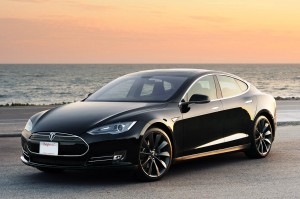 EVs have now been on the road in sizeable numbers for about five years though, so we’re starting to get some good data. And as Electrek reports, the news is pretty good, at least for Tesla batteries:
EVs have now been on the road in sizeable numbers for about five years though, so we’re starting to get some good data. And as Electrek reports, the news is pretty good, at least for Tesla batteries:
Data shows that the Model S’ battery pack generally only loses about 5% of its capacity within the first 50,000 miles and then the degradation significantly slows down with higher mileage. Plug-in America’s data shows several vehicles with over 100,000 miles driven and less than 8% degradation.
And anecdotally:
CEO Elon Musk once referred to a battery pack Tesla was testing in the lab. He said that the company had simulated over 500,000 miles on it and that it was still operating at over 80% of its original capacity.
This is all encouraging to hear, as that kind of degradation is relatively minor. And as noted, prices are coming down on batteries. It’s unclear if Tesla’s success though will translate to other EVs, as each company is using different chemistries and technologies. But the news on at least newer Nissans, for example, looks promising, too.
For some people it will take a lot more data like these to reassure them. So it’s nice to get some early returns and to see that the initial reports are generally positive. Otherwise, time will tell.
Elon Musk did his big reveal last night on the long-awaited Tesla Model 3, the most anticipated mass-market electric vehicle. The vehicle promises some pretty amazing things, mainly a minimum 215-mile range at a base price of $35,000. Meanwhile, it will have autopilot features now found on the company’s electric SUV Model X.
How can they do all this for that price? The answer is the “gigafactory” for batteries outside Reno, currently under construction. As Musk describes in the video above, it’s the largest footprint building in the world that will produce more lithium ion batteries than all other facilities in the world combined. Now that’s a textbook example of economies of scale.
And in terms of look, it’s hard to deny that this is one sporty-looking performance vehicle, with an all-glass roof (hello squeegees!) and sleek, Porsche-like lines:
Meanwhile, as of last night, over 115,000 people have already deposited $1,000 to pre-order one.
It’s hard to deny that this is a historic moment in the history of electric vehicles, and by extension sustainable transportation. While the Chevy Bolt promises similar range and price, Tesla has the cache and history of innovation to deliver a market winner for the masses.
But the car won’t be available for probably another two years. So what does that mean for the industry in the interim?
The effect could actually be counter-productive for the electric vehicle industry. With such an appealing car waiting in the wings, why would someone want to buy one of the existing models out there now, when they’re priced about the same but have less than half the range of the Model 3 and none of the cool features or glitz?
Just as an example, think of the “new” Nissan LEAF. After five years in production, the new version from Nissan basically looks the same as the original and only has 20 additional miles of range, to 105 miles. And it costs about $32,000 before incentives. So why would I buy that LEAF now when in two years, for the same price, I can get more than twice the range and all the excitement and features of a Tesla?
For buyers like me who want to stay electric, we’ll probably just continue leasing, in order to wait out the next two years until the Model 3 and possibly other models like it are on the market. While this dynamic has always been present to some extent (the belief that the technology is improving so rapidly it’s not worth investing in a new EV just yet), the Model 3 unveil could put that psychology on steroids.
If I were working at Nissan, Chevy or BMW right now, I’d sure be worried about this trend. And I’d also be on notice that the whole industry needs to up its game in response to the Model 3.
Electric vehicles have had a down year, and many people blame low gas prices, per the Associated Press:
At their peak in 2013, with gas averaging $3.50 per gallon, Americans bought only 341,000 hybrids and electrics, about 2.2 percent of total U.S. car sales, according to Kelley Blue Book.
Companies spent millions developing the cars, taking losses to meet government fuel economy standards that gradually increase and require the new-car fleet to average 54.5 miles per gallon by 2025.
As gas prices fell below $2 per gallon, sales of hybrids and electrics dropped further. Last year, automakers had 16 hybrid and electric models on sale, but sales sank to just over 274,000.
But poor marketing is a big part of the story, too. Many automakers tried to sell the vehicles as an eco-friendly alternative or competitor to the popular hybrid vehicles like the Toyota Prius. That might explain why the Nissan LEAF is called a “leaf” and looks vaguely like a goofy Prius.
But in their haste to please the eco crowd, these automakers were overlooking one critical attribute of an electric vehicle: they are fun to drive.
Tesla realized this early on, and as a result have successfully positioned their vehicles not just as an eco-toy for the rich but as a new and exciting technology that drives better than clunky old gas cars. In fact, most Tesla buyers don’t actually care about the environment but instead are interested in access to new technology.
But now with gas prices so low, other automakers are coming around to marketing the performance aspect, from the same article:
At the New York International Auto Show on Wednesday, Hyundai and Toyota showed off new electric and hybrid vehicles, with presenters from both companies touting them as “fun to drive.” Hyundai unveiled battery, gas-electric hybrid and plug-in versions of a new car called the Ioniq, while Toyota showed the plug-in Prius Prime, which can go 22 miles on electricity before the gas-electric power system kicks in. The electric range is double the old version.
It’s better late than never. There’s a much bigger market of people who want a fun car to drive than people who care about climate change and Saudi Arabia. So this is a good and long overdue pivot.
But perhaps more importantly, Tesla’s Model III (to be unveiled this week) and the Chevy Bolt — both 200-mile range vehicles for under $40,000 — will herald the beginning of truly mass-market EVs that can appeal to a broader market segment.
It will take some time, but between better marketing and vehicles with improved range at a lower cost, the battery electric revolution in driving will be here to stay.
And no other single technology could be more welcome for combating climate change.
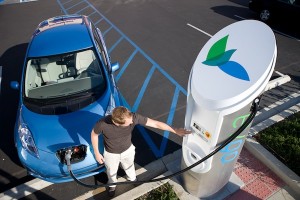 Lots of recent news on EV infrastructure:
Lots of recent news on EV infrastructure:
- The California Public Utilities Commission approved a major new utility investment in EV charging infrastructure this week, allowing San Diego Gas & Electric to install charging stations at “up to 350 businesses and multi-family communities throughout the region, with 10 chargers at each location for a total of 3,500 separate chargers,” per Clean Technica. At least 10% of the chargers will be in disadvantaged communities. It’s a step in the right direction, as electric utilities probably provide the best hope for getting adequate infrastructure up and running for EVs in the long run.
- The California Energy Commission is finally soliciting bids to put fast chargers in key travel corridors in California. Some of the prime routes include I-15 north of Victorville to outside of Las Vegas, I-10 from Beaumont past Palm Springs, and I-80 from Auburn out to Lake Tahoe. It’s about time.
- Tesla is killing it on their proprietary network of supercharger sites, adding about 50% more chargers in 2015 alone, per Green Car Reports. The company is on its way to becoming a vertically integrated monopoly. Imagine if GM owned all the great cars, plus all the gas stations and dealerships. That’s the path Tesla is on.
- But sadly, NRG is still lagging on their implementation of the $100 million settlement with the California Public Utilities Commission. The audit of their performance, announced over a year ago by the commission, has so far failed to materialize. I called the agency for a status update a few months ago and never heard back. In some ways, their failure to meet the terms of the agreement has created the need for more public dollars to go to this charging infrastructure investment, while Tesla’s success makes NRG’s slow progress look even worse by comparison.
In general, the infrastructure news is positive. But sales of plug-in electrics are still lagging due to cheap gas, failure to introduce new models with better range, and poor marketing. More work to be done, but this all-in-all a good start.

